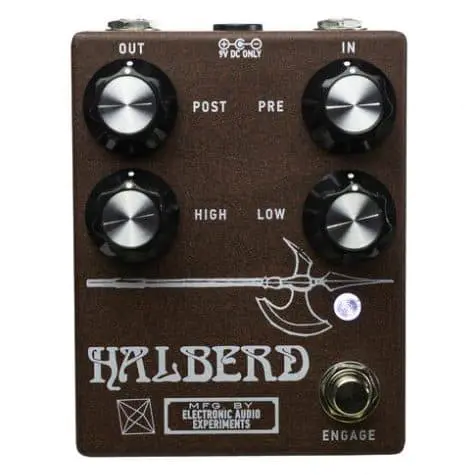
Boston’s Electronic Audio Experiments just unveiled a new flexible Overdrive called Halberd, in the words of the builder “a discrete transistor overdrive circuit designed for the greatest possible dynamic range and note clarity.”
Not to be filed under the “transparent ods”, and based on a circuit blending silicon and germanium transistors, the Haldberd offers a unique character that’s somewhere between blown-up tweed and an overdriven studio console.
Here’s what the controls do:
Pre: This sets the overall signal gain. Lower settings impart light compression, then increasing amounts of clipping up to a medium overdrive, depending on pickup output and the Low setting.
Low: This is an adjustable low frequency shelving filter at the input, and is very interactive with the setting of the Pre control.
High: This is an adjustable high shelf cut at the output, for taming harsher frequencies especially at high gain settings with Low cutting bass.
Post: This sets the overall output level, and is buffered for full transparency at all signal levels.
And here are some videos of the Electronic Audio Experiments Halberd.
The Electronic Audio Experiments Halberd is a discrete transistor overdrive circuit designed for the greatest possible dynamic range and note clarity. It is a novel addition to our family of drive pedals—a medium-gain device with the harmonic fullness and grind of a much higher-gain pedal, one that stands apart from both the brazen buzz of op amp distortion and the smooth breakup of JFET amp emulations alike.
The Halberd’s character comes from a jumble of silicon and germanium transistors working in harmony. It is familiar but unique, sitting somewhere between blown-up tweed and an overdriven console. Rather than resigning itself to transparency, it imparts its character in in a collaborative fashion, responding in unique ways to different instruments and amplifiers but not without leaving its distinct fingerprints. And of course, it is equally at home on guitar, bass, and synthesizer.
Controls:
Pre: This sets the overall signal gain. Lower settings impart light compression, then increasing amounts of clipping up to a medium overdrive, depending on pickup output and the Low setting.
Low: This is an adjustable low frequency shelving filter at the input, and is very interactive with the setting of the Pre control.
High: This is an adjustable high shelf cut at the output, for taming harsher frequencies especially at high gain settings with Low cutting bass.
Post: This sets the overall output level, and is buffered for full transparency at all signal levels.






















